In fess


![Ver [Brault, G. J.; 1997] en referencias bibliográficas. Libro abierto, hojas de plata, filo de oro, guardas de gules, tapas de sable.](../css/Libro.Bibliografia.png)
Brault, G. J.; 1997
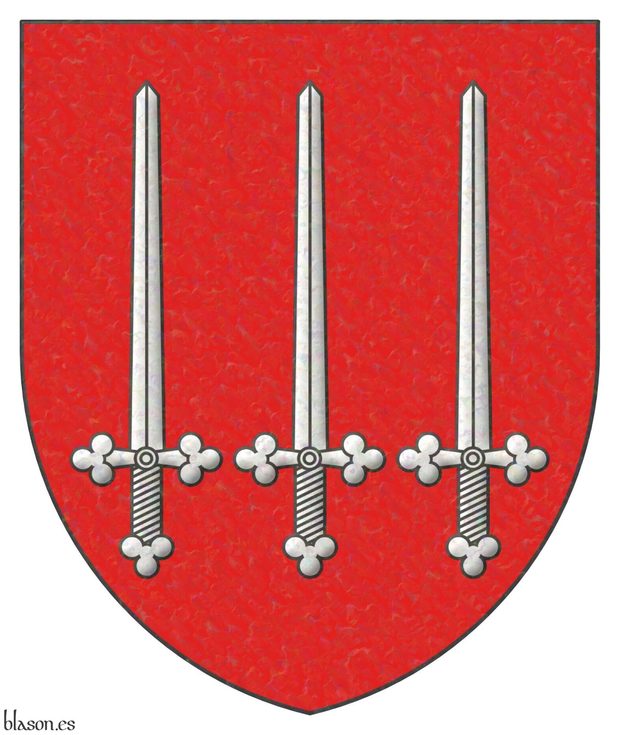
Gerard J. Brault, professor of French and Medieval Studies at Pennsylvania State University, «Rolls of Arms of Edward I, 1272-1307, Volume I and Volume II», is a set of 2 volumes, 1,104 pages, size 24.4 x 17.2 cm, with 3 color illustrations and 8 black and white illustrations, published by Boydell Press, Aspilogia series, ISBN 9780851156699, Suffolk, United Kingdom, May 1, 1997.
Another annotated edition exists from February 21, 2008, also published by Boydell Press.
The starting hypothesis of this book is that at the beginning of the second half of the 13th century, the use of coats of arms increased, this increase led to the appearance of the first armorials in which the names of their holders were recorded along with the descriptive blazon of their armory, and painted shields could be included.
From the Middle Ages, about 350 armorials have survived, of which 130 come from England, and they are a unique source for identifying many medieval figures, their titles, and their possessions. This book analyzes 17 of these armorials, such as the so-called [Marshal, L.; 1295; The Lord Marshal's Roll], which includes the coat of arms of William de Colebrand that illustrates this bibliographic reference.
Bibliographical reference of century XX.
Author: Brault, Gerard J..
Bibliographic reference mentioned in the following articles:
External link:

Colebrand, William de
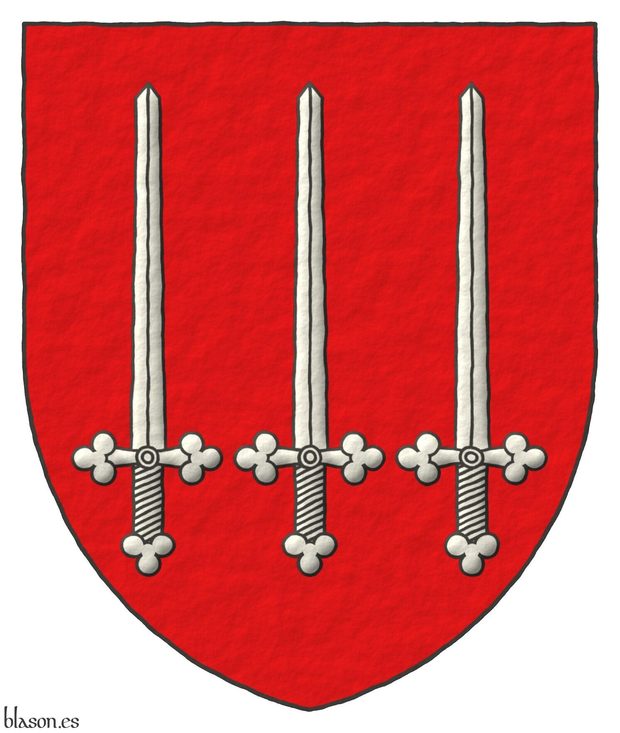
Willame de Colebraund ~ William de Colebrand.
Gules, three Swords Argent, erect, in fess.
Escudo de gules, tres espadas de plata, alzadas, en faja.
Interpreted coat of arms with a free hand finish.
Coat of arms included in [Marshal, L.; 1295; coat of arms number 461], also in [Brault, G. J.; 1997], and time ago in Brian Timms, but not now.
Blazon keywords: Without divisions, Gules, Three, Sword, Argent, Point upwards and In fess.
Style keywords: Pointed, Illuminated, Outlined in sable and Freehand.
Classification: Interpreted and Personal.
Bearer: Colebrand, William de.


Coulot, Fabian
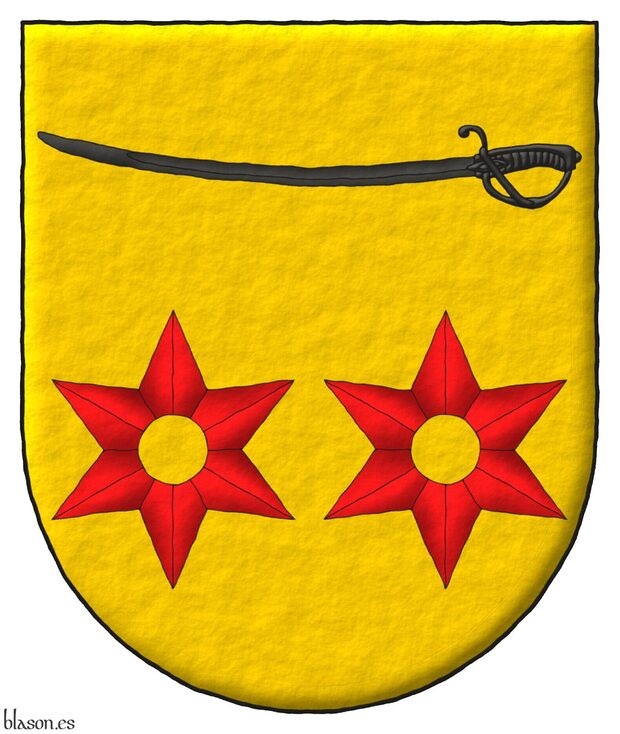
Or, two mullets of six points pierced in fess Gules; in chief a sabre fesswise Sable.
Escudo de oro, dos rosetas de espuela en faja de gules; en jefe, un sable puesto en faja de sable.
Coat of arms emblazoned by me with a semi-circular shape, illuminated, and with a freehand finishing.
Blazon keywords: Or, Two, Mullet of six points pierced, In fess, Gules, In chief, One, Sabre, Sword, Fesswise and Sable.
Style keywords: Outlined in sable, Semi-circular, Illuminated and Freehand.
Classification: Personal, Interpreted and Coat of arms.
Bearer: Coulot, Fabian.


Daubeny, Philip
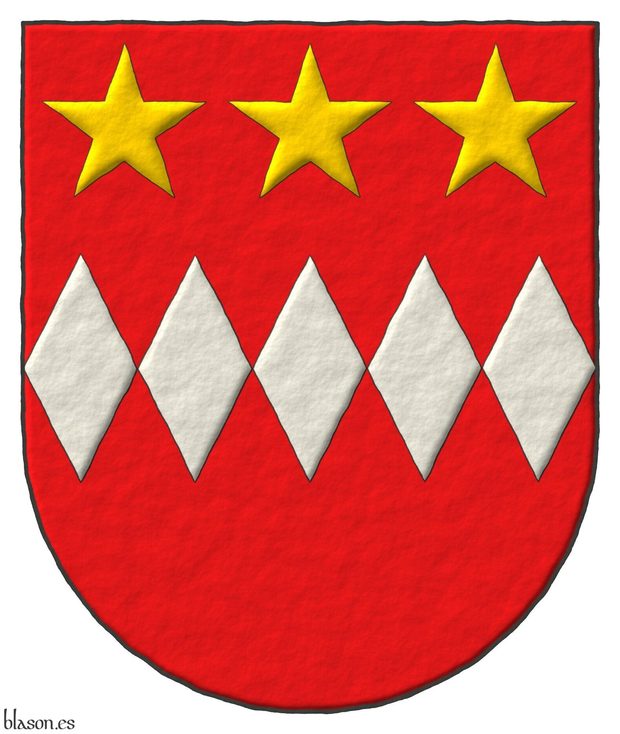
Philip Daubeney ~ Philip Daubeny.
Gules, a fess of five fusils Argent, in chief three mullets Or.
Escudo de gules, una faja de cinco fusos de plata, en jefe tres estrellas de oro.
Coat of arms interpreted with: the semicircular base shape; the field illuminated in Gules; the fusils illuminated in metal Argent, outlined in Sable; the fess of 5 fusils; the 3 mullets in chief of 5 points, illuminated in Or and outlined in Sable; and the whole with a raised-stroke effect.
The English term «mullet» used in this blazon refers to a 5-pointed, non-wavy star.
Blazon keywords: Gules, Fusil, Argent, In fess, Mullet, Or and In chief.
Style keywords: Semi-circular, Illuminated, Outlined in sable and Freehand.
Classification: Interpreted and Personal.
Bearer: Daubeny, Philip.


![Ver [In fess and fesswise] en criterios utilizados. Unicornio saltante sobre la divisa, criterio.](../css/Unicornio.Criterio.png)
In fess and fesswise
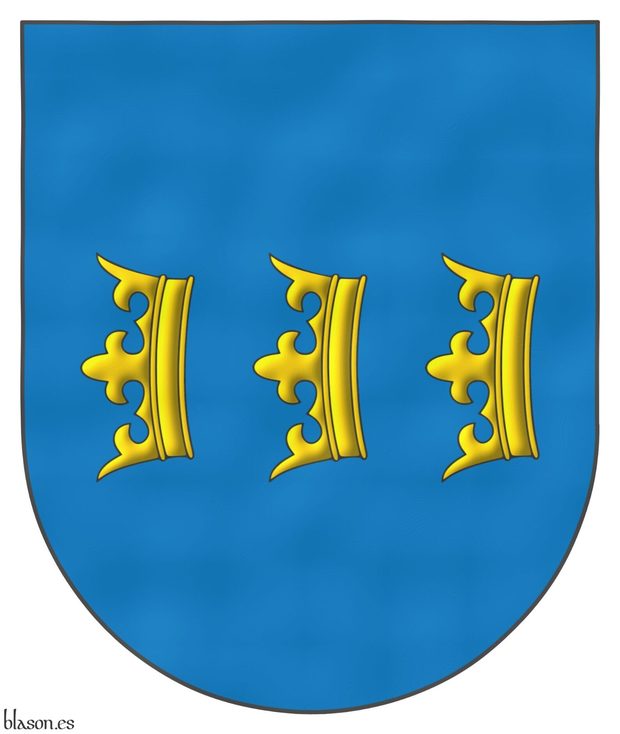
Azure, three crowns in fess, fesswise Or.
Escudo de azur, tres coronas en faja, puestas en faja de oro.
Crown with the main axis being the vertical and central axis of symmetry and which is usually placed palewise.
- In fess ~ en faja.
- Fesswise ~ puesto en faja.
Blazon keywords: Without divisions, Azure, Or, Crown, In fess and Fesswise.
Style keywords: Semi-circular, Outlined in sable and Watercolor.
Classification: Criterion.
Bearer: In and wise.


Julio Hector Aspe, structured and parallel blazons
Coat of arms of Julio Hector Aspe designed by him and me, and emblazoned by me, with the blazon written in English and Castilian in a structured way to observe the parallelism between both forms.
Blazon keywords: Azure, Argent, Or, One, Two, Trumpet, Bend sinisterwise, Debruised, Fish, Haurient, Sword, Point downwards, Between, Fleur de lis and In fess.
Style keywords: Outlined in sable, Illuminated, Ogee Triple-Pointed and Leather.
Classification: Personal, Created, Structured and parallel blazons, Boa and Coat of arms.
Bearer: Aspe, Julio Hector.


![Ver [Marshal, L.; 1295] en referencias bibliográficas. Libro abierto, hojas de plata, filo de oro, guardas de gules, tapas de sable.](../css/Libro.Bibliografia.png)
Marshal, L.; 1295
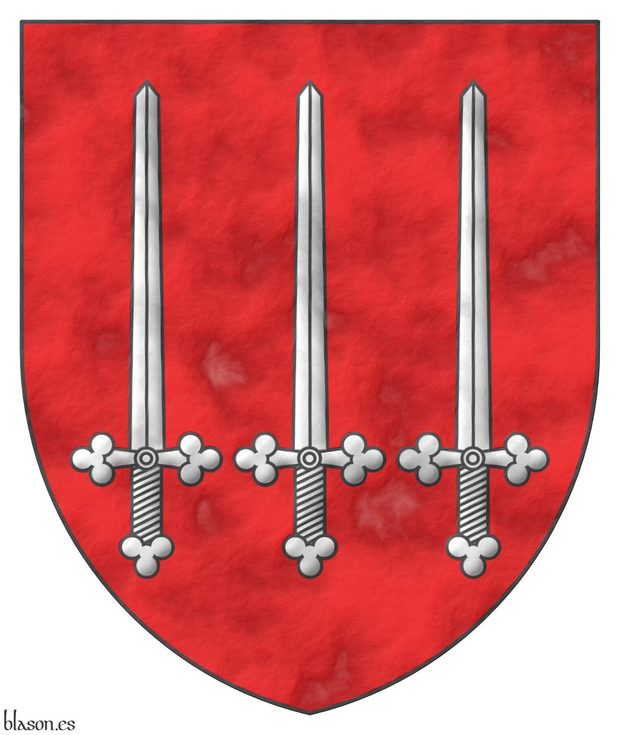
Lord Marshal, «The Lord Marshal's Roll», deposited in the Society of Antiquaries of London, code ms664, volume 1, ff 19-25, contains 565 painted shields, of which 42 are blank and 48 do not have the name of their associated holder, dated 1295.
This armorial contains the systematic error of representing, in many of its registered shields, the metal gold as metal silver, and some of its shields are not easy to decipher. Therefore, this armorial cannot be considered a completely reliable and definitive source of certain coats of arms.
[Brault, G. J.; 1997] is a good reference for the analysis of this armorial and in Brian Timms you can see a current interpretation of the coats of arms recorded in it, among them the shield of William de Colebrand that illustrates this bibliographic reference.
At the beginning of the second half of the 13th century, the use of coats of arms increased, this increase led to the appearance of the first armorials in which the name of their holders was recorded along with the blazon describing their coats of arms, possibly including the painted shields.
Bibliographical reference of century XIII.
Author: Marshal, Lord.
Here are the articles quoting this reference:
External link:


Martos García, Juan Carlos
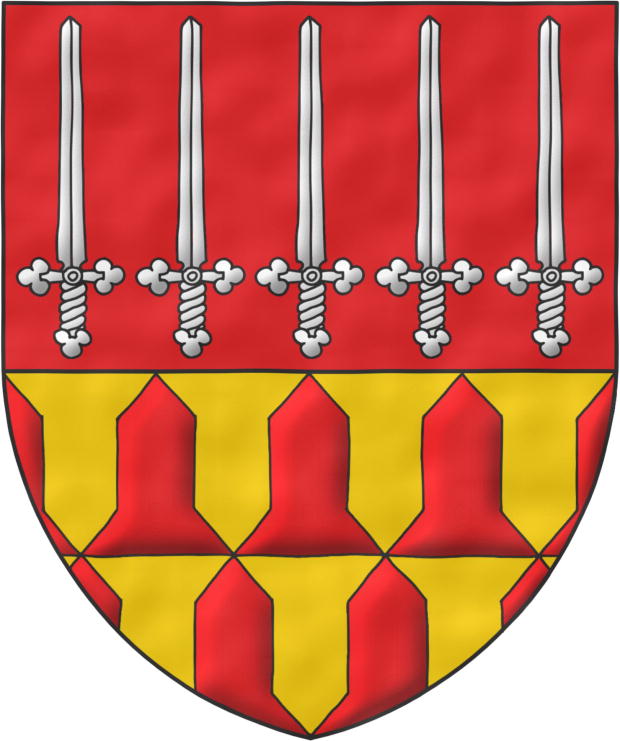
Party per fess: 1 Gules, five Swords Argent, erect, in fess; Vairy or and gules gules and or.
Escudo cortado: 1o de gules, cinco espadas de plata, alzadas, en faja; 2o verado de oro y gules.
Symbology
There are 6 swords raised to defend the truth, symbolised by the vairy fur, and no matter how much time passes, they will be proud and erect until the truth triumphs.
Blazon keywords: Party per fess, Gules, Or, Argent, Five, Sword, Vairy, Point upwards and In fess.
Style keywords: Pointed, Illuminated, Outlined in sable and Watercolor.
Classification: Created, Personal and Coat of arms.
Bearer: Martos García, Juan Carlos.


Photos of the Grant G0134 for the arms of Myriam Spiteri Debono
Tierced per pale: 1 Or, upon a fess Azure a lion passant Gules holding a sword point upwards Argent [for Spiteri]; 2 Azure, upon a base Vert a tree eradicated proper, supported at sinister by a man proper wearing a loincloth Argent and holding in his sinister a spear point upwards Or and in chief three mullets of six points in fess Or [for Debono], 3 Gules, two hands clasped throughout proper, vested Argent, holding a dagger point upwards Argent, hilted Or, in chief three mullets of six points in fess Or and in base a sprig of olive fesswise proper [for Zammit]. Crest: Upon a helm, befitting her degree as President of Malta, with a wreath Or and Gules, an escutcheon Bleu celeste, issuant from a base wavy Argent, charged with three bars wavy Azure, three arches interlaced in fess Or. Mantling: Gules doubled Argent. Supporters: Two lions rampant Or, langued Gules, terraced by a mound Vert. Motto: «Servire Cum Modestia». The shield is surrounded by the Xirka Gieh ir-Repubblika and the Grand Collar of Malta's National Order of Merit, as Head of both.
Personal coat of arms of Her Excellency Myriam Spiteri Debono, President of Malta, grant G0134 by Dr. Charles A. Gauci, Chief Herald of Arms of Malta. These arms, which I emblazoned for grant G0134, are shown here together with two photographs of the grant’s cover and the page displaying the coat of arms.
Blazon keywords: Or, Azure, Gules, Argent, Vert, Bleu celeste, One, Two, Three, Tierced per pale, Fess, Lion, Passant, Sword, Point upwards, Base, Tree, Eradicated, Proper, Sinister, Male figure, Loincloth, Spear, In chief, Mullet, In fess, Two hands clasped, Dagger, Hilted, In base, Sprig, Olive tree, Fesswise, Crest, Upon (wreath), Helm, Wreath, Escutcheon, Ensigned by, Wavy, Bar, Arch, Interlaced, Mantling, Rampant, Compartment, Motto, Surrounded, Decoration and Grand collar.
Style keywords: Outlined in sable, Illuminated and Pointed.
Classification: Personal, Interpreted, Boa, Collage and Photographic.
Bearer: Spiteri Debono, Myriam.


Quesada Valles, Bartolomé
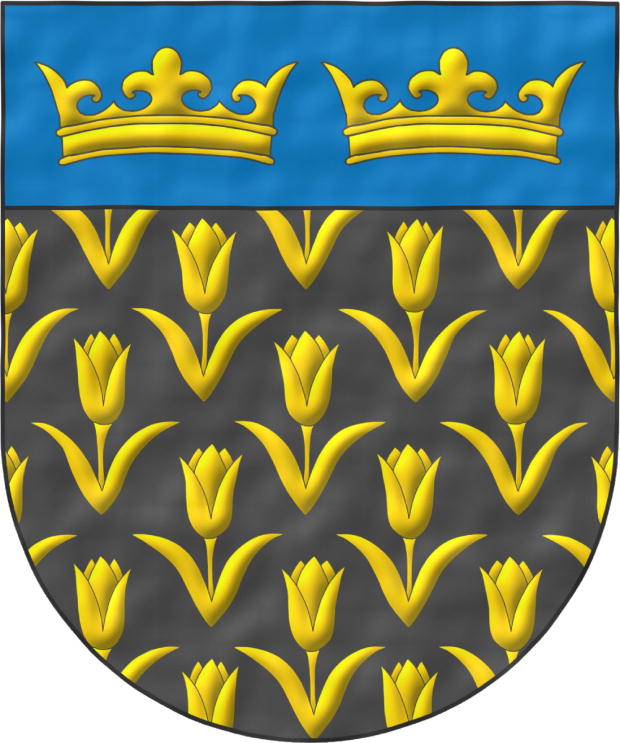
Sable, semé of Tulips Or; on a chief cousu Azure, two Crowns Or, in fess.
Escudo de sable, sembrado de tulipanes de oro; el jefe cosido de azur, dos coronas de oro, en faja.
The original design of this coat of arms, along with many others heraldic devices, is registered in [Salmerón Cabañas, A.; 2015a; page 11].
Blazon keywords: Without divisions, Sable, Or, Azure, Chief, Two, Crown, In fess, Semé and Tulip.
Style keywords: Watercolor, Semi-circular, Illuminated, Outlined in the field tincture, Outlined in sable and Cousu.
Classification: Coat of arms, Created and Personal.
Bearer: Quesada Valles, Bartolomé.


Rauf Daubeny
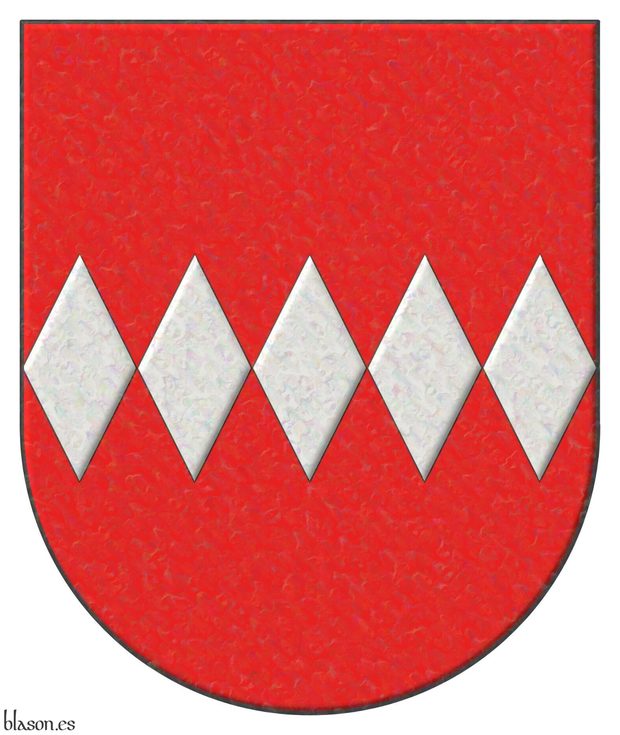
Ralph de Albini ~ Rauf de Albini.
Gules, a fess of five fusils Argent.
Escudo de gules, una faja de cinco fusos de plata.
Coat of arms interpreted in the following manner: the shape of the base is semicircular; the field is illuminated in Gules; the fusils outlined in Sable and illuminated in metal Argent; the fess is 5 fusils in length; and the whole with an iridescent finish.
I tend to blazon «Gules, a fess of five fusils Argent» ~ «Escudo de gules, una faja de cinco fusos de plata» which, as the piece called a fess touches the edges of the shield and is a unit, means the fusils touch the edges of the shield and touch each other, forming a single fess of 5.
While in the blazon «Gules, five fusils in fess Argent.» ~ «Escudo de gules, cinco fusos en faja de plata» the fusils neither touch each other nor the edges of the shield; this second blazon tells us that the fusils are «in fess» ~ «en faja», it does not tell us that they are forming a fess.
Blazon keywords: Gules, Fusil, Argent and In fess.
Style keywords: Semi-circular, Illuminated, Outlined in sable and Iridescent.
Classification: Interpreted and Personal.
Bearer: Daubeny, Rauf.


Simon de Crombe
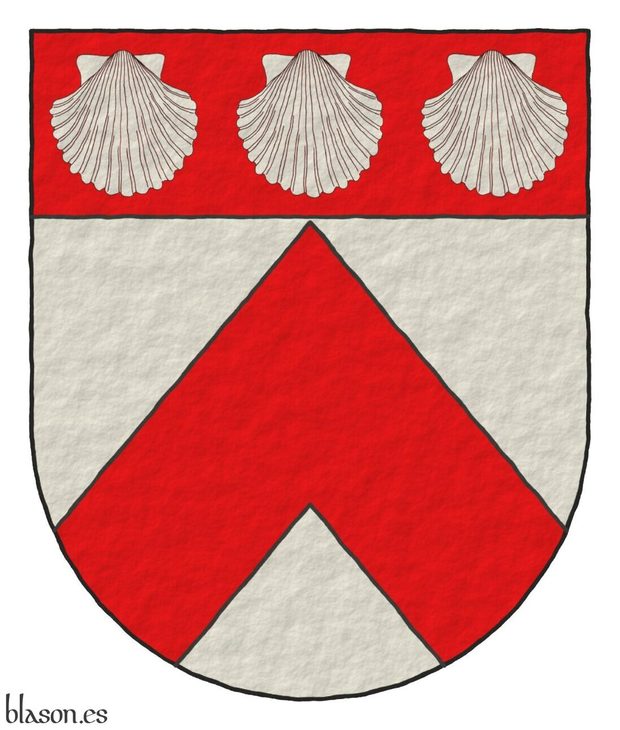
Simon de Croome ~ Simon de Crombe.
Argent, a Chevron Gules, on a Chief Gules, three escallops Argent, in fess.
Escudo de plata: un cabrio de gules; el jefe de azur, tres veneras de plata, en faja.
Included in [Vincent, MS; 1285; number 623] also known as [St. George's Roll; 1285; number 623].
The 3 escallops are in the chief then the description «in fess» are not really needed.
Blazon keywords: Without divisions, Argent, One, Chevron, Gules, Chief, Three, Escallop and In fess.
Style keywords: Semi-circular, Plain tincture, Outlined in sable and Freehand.
Classification: Interpreted and Personal.
Bearer: Simón de Croome.


The coat of arms of Miguel Francisco Lanzagorta Escutia outlined
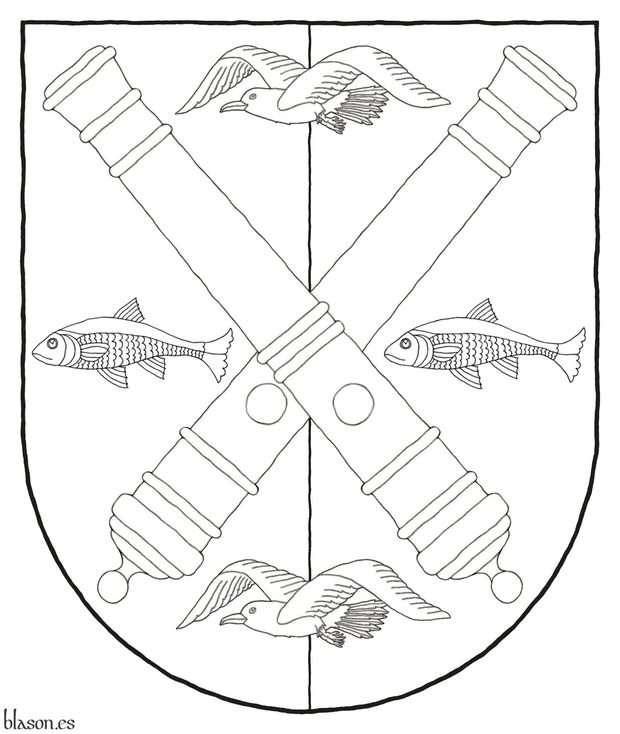
Party per pale Vert and Azure, overall two cannons dismounted in saltire, between two seagulls volant in pale, and two fish naiant in fess Argent.
Blazon keywords: Party per pale, Vert, Azure, Overall, Two, Cannon dismounted, Cannon, In saltire, Between, Seagull, Volant, In pale, Fish, Naiant, In fess and Argent.
Style keywords: Semi-circular, Outlined in sable and Outlined.
Classification: Personal, Interpreted and Coat of arms.
Bearer: Lanzagorta Escutia, Miguel Francisco.
-
Language
-
Categories of heraldry
-
Divisions of the field
- Without divisions
- Party per pale
- Party per fess
- Party per bend
- Party per bend sinister
- Tierce
- Tierce sinister
- Tierced per pale
- Tierced per fess
- Tierced per bend
- Tierced pallwise inverted
- Quarterly
- Quarterly per saltire
- Gyronny
- Party per fess, the chief per pale
- Party per pale, the sinister per fess
- Party per fess, the base per pale
- Party per pale, the dexter per fess
- Chapé
- Chaussé
- Embrassé
- Contre-embrassé
- Party per chevron
- Enté
- Enté en point
- Flanched
-
Metals
-
Colours
-
Furs
-
Other tinctures
-
Ordinaries and sub-ordinaries
-
Diminutives of the ordinaries
-
Geometric charges
-
Composite ordinaries
-
Inanimate charges from Nature
Atom, Crescent, Diamond, Emerald, Estoile, Increscent, Lightning flash, Moon, Mount, Mullet, Mullet of four points, Orbital, Plough of Ursa Major, Rainbow, Ray of the sun, River, Sea, Snowflake, Sun, Sun in splendour, Sun of May, Trimount, Water and Wave.
-
Vegetal charges from Nature
Acorn, Apple, Apple tree, Ash, Bluebonnet, Camellia, Chrysanthemum, Cinquefoil, Cornflower, Dogwood flower, Double rose, Elm, Fleur de lis, Flower, Gourd, Holm oak, Hop cone, Kapok tree, Laurel, Lily, Linden, Lotus flower, Madonna lily, Oak, Olive tree, Palm tree, Pomegranate, Poplar leaf, Rose, Shamrock, Sunflower, Thistle, Tree, Tulip, Vine and Wheat.
-
Animal charges from Nature
Badger, Bald eagle, Barbel, Barn owl, Bear, Beaver, Beetle, Bighorn sheep, Blackbird, Boar, Brach hound, Bull, Doe, Dog, Dolphin, Dove, Eagle, Elephant, Falcon, Fish, Flame, Fly, Fox, Frog, Goat, Goldfinch, Goose, Heron, Horse, Hummingbird, Jaguar, Lark, Leopard, Lion, Lion passant, Lion rampant guardant, Lioness, Lynx, Male figure, Martlet, Merino ram, Owl, Panther, Parrot, Peacock, Pelican, Pelican in her piety, Puffin, Quetzal, Raven, Roe deer, Rooster, Savage, Seagull, Serpent, She-wolf, Stag, Starling, Talbot, Tyger, Vulture, Warren hound and Wolf.
-
Parts of natural charges
Arm, Beak, Branch, Caboshed, Chest, Claw, Covert, Dorsal fin, Eagle claw, Ermine spot, Escallop, Feather, Foot (palmiped), Foreleg, Forepaw, Hand, Head, Heart, Hoof, Leaf, Neck, Ostrich feather, Palm frond, Paw, Roe deers' attires, Shoulder, Sprig, Stags' attires, Stem, Swallow-tail, Tail, Tail addorsed, Tail fin, Talon, Tooth, Trunk, Trunk (elephant), Two hands clasped, Two wings in vol, Udder, Wheat spike, Wing and Wrist.
-
Artificial charges
Ace of spades, Anchor, Anvil, Arch, Arm vambraced, Armillary sphere, Arrow, Axe, Bell, Bell tower, Beret, Bonfire, Book, Bookmark, Bow, Bridge, Broken, Buckle, Cannon, Cannon dismounted, Cannon port, Canopy roof, Carbuncle, Castle, Celtic Trinity knot, Chain, Chess rooks, Church, Clarion, Clay pot, Closed book, Club, Column, Comb, Compass rose, Conductor's baton, Cord, Covered cup, Crozier, Crucible, Cuffed, Cup, Cyclamor, Dagger, Double vajra, Drum, Ecclesiastical cap, Fanon, Federschwert, Fleam, Four crescents joined millsailwise, Galician granary, Garb, Gauntlet, Geometric solid, Grenade, Halberd, Hammer, Harp, Host, Hourglass, Key, Key ward, Knight, Knot, Lantern, Letter, Line, Loincloth, Menorah, Millrind, Millstone, Millwheel, Monstrance, Mortar, Mullet of six points pierced, Nail, Non-classic artifact, Norman ship, Number, Oar, Oil lamp, Open book, Page, Pair of scales, Parchment, Pestle, Piano, Pilgrim's staff, Plough share, Polish winged hussar, Port, Portcullis, Potent, Quill, Ribbon, Rosette of acanthus leaves, Sabre, Sackbut, Sail, Scroll, Scythe, Sheaf of tobacco, Ship, Skirt, Spear, Spear's head, Stairway, Star of David, Step, Sword, Symbol, Tetrahedron, Torch, Tower, Trident, Trumpet, Turret, Two-handed sword, Wagon-wheel, Water-bouget, Wheel, Winnowing fan and With a turret.
-
Immaterial charges
Angel, Archangel, Basilisk, Dragon, Dragon's head, Garuda, Golden fleece, Griffin, Heart enflamed, Mermaid, Our Lady of Mercy, Ouroboros, Paschal lamb, Pegasus, Phoenix, Sacred Heart of Jesus, Saint George, Sea-griffin, Trinity, Triton, Unicorn, Winged hand and Wyvern.
-
External elements
-
Heraldic creations
-
References
-
Formats
-
Keywords on this page
Between, Watercolor, Proper, Two hands clasped, Point upwards, Pointed, Arch, Eradicated, Aspe, Julio Hector, Azure, Point downwards, Bibliography, Structured and parallel blazons, Boa, Overall, Bar, Wreath, Chevron, Base, Cannon, Bleu celeste, Upon (wreath), Crest, Crown, Created, Outlined in sable, Two, In fess, In chief, Coat of arms, Sword, Mullet, Fusil, Personal, Gules, Illuminated, Interpreted, Chief, Semi-circular, Or, Fish, Argent, Without divisions, Fesswise, Sable, Vert, Freehand, Three and One.

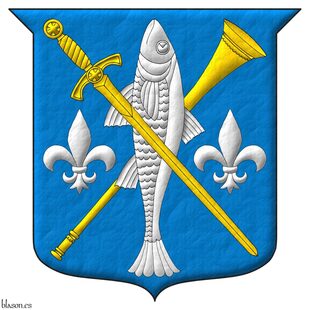
![Photos of the Grant G0134 for the arms of Myriam Spiteri Debono Tierced per pale: 1 Or, upon a fess Azure a lion passant Gules holding a sword point upwards Argent [for Spiteri]; 2 Azure, upon a base Vert a tree eradicated proper, supported at sinister by a man proper wearing a loincloth Argent and holding in his sinister a spear point upwards Or and in chief three mullets of six points in fess Or [for Debono], 3 Gules, two hands clasped throughout proper, vested Argent, holding a dagger point upwards Argent, hilted Or, in chief three mullets of six points in fess Or and in base a sprig of olive fesswise proper [for Zammit]. Crest: Upon a helm, befitting her degree as President of Malta, with a wreath Or and Gules, an escutcheon Bleu celeste, issuant from a base wavy Argent, charged with three bars wavy Azure, three arches interlaced in fess Or. Mantling: Gules doubled Argent. Supporters: Two lions rampant Or, langued Gules, terraced by a mound Vert. Motto: «Servire Cum Modestia». The shield is surrounded by the Xirka Gieh ir-Repubblika and the Grand Collar of Malta's National Order of Merit, as Head of both.](../escudo_armas/G0134.30.Grant.Collage.jpg)